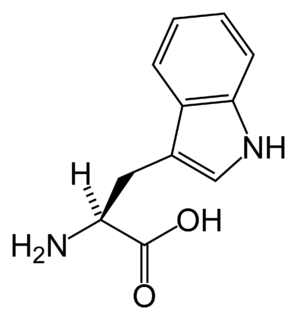
Occipital horn syndrome (OHS), formerly considered a variant of Ehlers–Danlos syndrome, is an X-linked recessive mitochondrial and connective tissue disorder. It is caused by a deficiency in the transport of the essential mineral copper, associated with mutations in the ATP7A gene.

Carnosine (beta-alanyl-L-histidine) is a dipeptide molecule, made up of the amino acids beta-alanine and histidine. It is highly concentrated in muscle and brain tissues. Carnosine was discovered by Russian chemist Vladimir Gulevich.

Angiotensin-converting enzyme, or ACE, is a central component of the renin–angiotensin system (RAS), which controls blood pressure by regulating the volume of fluids in the body. It converts the hormone angiotensin I to the active vasoconstrictor angiotensin II. Therefore, ACE indirectly increases blood pressure by causing blood vessels to constrict. ACE inhibitors are widely used as pharmaceutical drugs for treatment of cardiovascular diseases.

Aceruloplasminemia is a rare autosomal recessive disorder in which the liver can not synthesize the protein ceruloplasmin properly, which is needed to transport copper around the blood. Copper deficiency in the brain results in neurological problems that generally appear in adulthood and worsen over time. .
Pyruvate dehydrogenase deficiency is a rare neurodegenerative disorders associated with abnormal mitochondrial metabolism. PDCD is a genetic disease resulting from mutations in one of the components of the pyruvate dehydrogenase complex (PDC). The PDC is a multi-enzyme complex that plays a vital role as a key regulatory step in the central pathways of energy metabolism in the mitochondria. The disorder shows heterogeneous characteristics in both clinical presentation and biochemical abnormality.

Protein AMBP is a protein that in humans is encoded by the AMBP gene.

Xaa-Pro dipeptidase, also known as prolidase, is an enzyme that in humans is encoded by the PEPD gene.

Dipeptidyl-peptidase 3 is an enzyme that in humans is encoded by the DPP3 gene.

Cathepsin H is a protein that in humans is encoded by the CTSH gene.

Dipeptidase 1 (DPEP1), or renal dipeptidase, is a membrane-bound glycoprotein responsible for hydrolyzing dipeptides. It is found in the microsomal fraction of the procine kidney cortex. It exists as a disulfide-linked homodimer that is glygosylphosphatidylinositol (GPI)-anchored to the renal brush border of the kidney. The active site on each homodimer is made up of a barrel subunit with binuclear zinc ions that are bridged by the Gly125 side-chain located at the bottom of the barrel.

Aspartate aminotransferase, cytoplasmic is an enzyme that in humans is encoded by the GOT1 gene.

Beta-Ala-His dipeptidase is an enzyme that in humans is encoded by the CNDP1 gene.

Dipeptidase 2 (DPEP2) is a protein which in humans is encoded by the DPEP2 gene.

N-Acetylcarnosine (NAC) is a naturally occurring compound chemically related to the dipeptide carnosine. The NAC molecular structure is identical to carnosine with the exception that it carries an additional acetyl group. The acetylation makes NAC more resistant to degradation by carnosinase, an enzyme that breaks down carnosine to its constituent amino acids, beta-alanine and histidine.

Hypertryptophanemia is a rare autosomal recessive metabolic disorder that results in a massive buildup of the amino acid tryptophan in the blood, with associated symptoms and tryptophanuria.

Xaa-His dipeptidase is an enzyme. This enzyme catalyses the following chemical reaction
Xaa-methyl-His dipeptidase is an enzyme. This enzyme catalyses the following chemical reaction

Cytosolic non-specific dipeptidase also known as carnosine dipeptidase 2 is an enzyme that in humans is encoded by the CNDP2 gene. This enzyme catalyses the following chemical reaction
Beta-Ala-His dipeptidase is an enzyme. This enzyme catalyses the following chemical reaction
Ernst Klenk was a German biochemist, known as a pioneer in research on biolipids, their metabolism, and diseases caused by biolipid disorders.
















